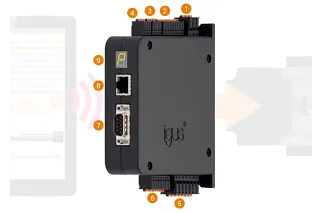Change Language :
dryve motor control

Select, click, control...
Traverse paths, positions, speeds, running times - simply defined with the new web-based control system for drylin® E linear systems from igus®.
- No software or app installation required, quick commissioning
- Control system can be operated via smartphone (browser), tablet or laptop
- Simple and intuitive user interface, control system set up in just a few minutes
- Compatible with numerous industrial control systems (e.g. Siemens S7 / Beckhoff). Learn more
- For DC, EC and stepper motors
- cost-effective
All relevant documents - flyers and technical data, the latest firmware, operating instructions, CANopen Electronic Data Sheet, 2D and 3D drawings - can be found in the shop under Downloads for the respective product.
dryve Test motor control
Using the intuitive browser interface, you can set the travel mode, positions, accelerations, speed and pause times of your linear axis in just a few minutes without any prior knowledge.
Test the user interface of the motor controller here using a simulated linear axis. Just as in this simulation, your input is transferred directly when using the real control system. There is no need for a separate transfer.
It's that simple: Under Driving profiles, you can configure up to eight lines and transfer the control system to the linear axis with one click. In the Mode field, use HOM to set the zero point or ABS to set the absolute position for the movement on the linear axis. Select the target by entering the position on the axis or by using the Teach function. Enter values for acceleration, speed and deceleration and, if necessary, a pause time. Under Next set, specify the number of the next travel profile.
The control system in detail
Videos
Technical data
nominal voltage Logic supply
12 - 24 VDC
nominal voltage load supply
12-48VDC
Motor types
2-phase stepper motor bipolar (ST), direct current motor (DC), electronically commutated motor (EC)
Continuous motor current
7A
Peak motor current
ST: 10A, DC: 14A, EC: 21A max. 2 sec depending on frequency of movement
Load power output
max. 340W continuous
Output current digital outputs
max. 200mA per output
Holding brake
24V DC/1A
Angular encoder
Hall sensor (2 or 3 pole), encoder (line driver RS422 or single ended)
analogue feedback via analogue inputs
Digital inputs
10 digital inputs, predefined function, selection NPN or PNP, built-in pull-down (PNP) and pull-up (NPN) resistors, short-circuit-proof, galvanically isolated, 5 - 24 VDC (external)
Digital outputs
5 digital outputs, function predefined, PNP, built-in pull-down resistors, short-circuit-proof, galvanically isolated, 5 - 24 VDC (external)
Analogue inputs
2 analogue inputs, ±10 VDC signal (12 bit), 0-10 VDC signal (11 bit), 10 VDC power supply
Interfaces
CANopen (DS 402), Modbus TCP as gateway (CiA 309), Ethernet, bit coding, cycle/direction
Operating modes
Open loop with/without position monitoring, closed loop
Driving modes
Binary: 32 traverse positions Jog Teach: 8 traverse positions in combination with external jog mode
Clock/direction: Ext. Setpoint specification
CE mark according to electromagnetic compatibility guideline
EN 61000-6-2:2005, EN 61000-6-3:2007
Ambient temperature
-20 °C to +45 °C
Relative humidity
≤ 90%, non-condensing
Maximum temperature of the power unit
100°C
Bearing temperature
-40°C to +60°C
Protection class
IP 30
Protective functions
Power unit temperature monitoring, current monitoring, undervoltage/overvoltage protection, tracking error detection, encoder monitoring
Fastening
Screw assembly, top-hat (DIN) rail installation
D x W x H in mm (incl. connectors and mounting elements)
124 x 31 x 139
Consulting
I look forward to answering your questions

Shipping and consultation
In person:
Monday to Friday from 8:30am - 5.30 pm.
Online:
24h
WhatsApp-Service:
Monday - Friday: 8:30am - 5.30 pm.